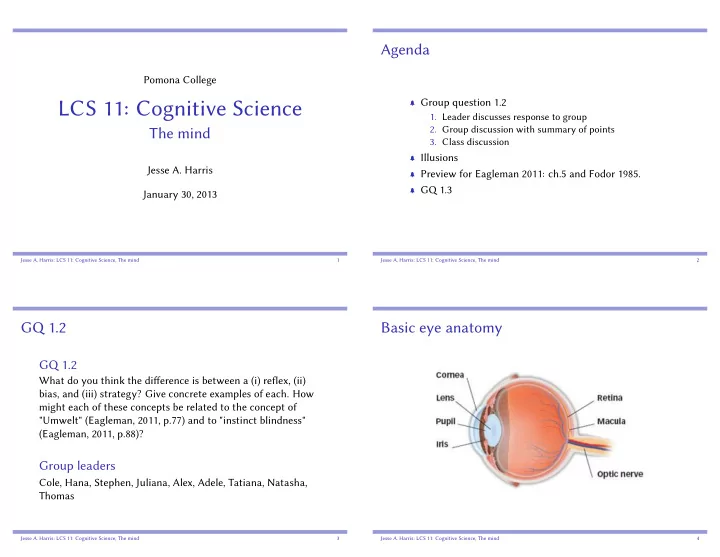

Agenda Pomona College ֠ Group question 1.2 LCS 11: Cognitive Science 1. Leader discusses response to group 2. Group discussion with summary of points The mind 3. Class discussion ֠ Illusions Jesse A. Harris ֠ Preview for Eagleman 2011: ch.5 and Fodor 1985. ֠ GQ 1.3 January 30, 2013 Jesse A. Harris: LCS 11: Cognitive Science, The mind 1 Jesse A. Harris: LCS 11: Cognitive Science, The mind 2 Basic eye anatomy GQ 1.2 GQ 1.2 What do you think the difference is between a (i) re fl ex, (ii) bias, and (iii) strategy? Give concrete examples of each. How might each of these concepts be related to the concept of "Umwelt" (Eagleman, 2011, p.77) and to "instinct blindness" (Eagleman, 2011, p.88)? Group leaders Cole, Hana, Stephen, Juliana, Alex, Adele, Tatiana, Natasha, Thomas Jesse A. Harris: LCS 11: Cognitive Science, The mind 3 Jesse A. Harris: LCS 11: Cognitive Science, The mind 4
The eye and the blindspot Illusions Types of illusion Illusions can a ff ect any one of our sensory modalities: 1. Visual 2. Auditory 3. Taste 4. Touch Truth in illusion What do systematic misinterpretations reveal about the cognitive system? Jesse A. Harris: LCS 11: Cognitive Science, The mind 5 Jesse A. Harris: LCS 11: Cognitive Science, The mind 6 Perceptual illusions Müller Lyer illusion ◮ Observed by the Greeks (of course) ◮ Scienti fi c study of illusions began with L. A. Necker (1832) ◮ Occur when brain attempts to interpret a 2 dimensional representation in 3 dimensions and is misled by the visual input. We might define illusions as deviations from kitchen physics ...For both science and perception phenomena cannot speak for themselves. Phenomena have to be interpreted to have significance. Inferences are not directly from phenomena or data, but from interpretation. Richard Gregory (2009). Seeing through illusions Jesse A. Harris: LCS 11: Cognitive Science, The mind 7 Jesse A. Harris: LCS 11: Cognitive Science, The mind 8
Müller Lyer illusion Ebbinghaus circles Jesse A. Harris: LCS 11: Cognitive Science, The mind 9 Jesse A. Harris: LCS 11: Cognitive Science, The mind 10 Kanizsa triangle Necker cube Jesse A. Harris: LCS 11: Cognitive Science, The mind 11 Jesse A. Harris: LCS 11: Cognitive Science, The mind 12
Rubin vase Blivet illusion Jesse A. Harris: LCS 11: Cognitive Science, The mind 13 Jesse A. Harris: LCS 11: Cognitive Science, The mind 14 Penrose triangle Is consciousness required? Open question What is the role of consciousness in perceptual illusions? What does the existence – and power – of illusions indicate about the relationship between consciousness and perception? http://www.youtube.com/watch?v=Ffy1uDiu764 Jesse A. Harris: LCS 11: Cognitive Science, The mind 15 Jesse A. Harris: LCS 11: Cognitive Science, The mind 16
Visual cues Visual cues ◮ Not just a single representation ◮ In some sense, all “pictures depicting depth are ◮ Multiple representations depicting aspects of an image paradoxical, for we see them as fl at (which they really ◮ Early visual processing organized into various types of are) and in a kind of suggested depth which is not quite cues, with multiple sources of information right” (Gregory 1968) 1. Color ◮ Brain uses a host of visual cues to give pictures depth and 2. Luminance texture 3. Texture ◮ Con fl icting cues can give rise to con fl icting inferences, 4. Relative size resulting in an illusion. 5. Cues from motion 6. Depth Jesse A. Harris: LCS 11: Cognitive Science, The mind 17 Jesse A. Harris: LCS 11: Cognitive Science, The mind 18 Visual cues Motion perception ◮ Brain evolved to see motion ◮ One defense against good camou fl age ◮ Employs heuristics: brain favors a perception of the world that is continuous ◮ Good evidence that neural pathway for detecting motion is distinct from other visual pathways (more on that next time) http://www.youtube.com/watch?v=hCV2Ba5wrcs Jesse A. Harris: LCS 11: Cognitive Science, The mind 19 Jesse A. Harris: LCS 11: Cognitive Science, The mind 20
Apparent motion Gregory’s look-up model “Perception seems, then, to be a matter of ‘looking-up’ stored information of objects, and how they behave in various situations. Such systems have great advantages.” Gregory 1968, page 6 1. Enhance speed of recognition 2. Predictive 3. Continue to function even without input 4. Redundancy to cut down on signal-noise ratio ◮ Create and store partial models of the world ◮ Information is accessed when assessing new input ◮ Past experience guides present perception Jesse A. Harris: LCS 11: Cognitive Science, The mind 21 Jesse A. Harris: LCS 11: Cognitive Science, The mind 22 Auditory visual illusions GQ 1.3 due Sunday, Feb 3, by 9PM GQ 1.3 McGurk e ff ect Take a simple action or mental process of your choosing and Perceptual blending of sounds due to competing information identify at least three distinct subprocesses that might be across auditory and visual modalities. involved in performing that action or process. Which, if any, of those subprocesses might be called modular in Fodor’s (1985) McGurk Effect in action: sense, and why? http://www.youtube.com/watch?v=G-lN8vWm3m0 Bill, bill, bill, ... Group leaders http://www.youtube.com/watch?v=KiuO_Z2_AD4 Sam, Audrey, Lea Lynn, Daniel, Joel, Noah, Jun, Sarah, Paul Jesse A. Harris: LCS 11: Cognitive Science, The mind 23 Jesse A. Harris: LCS 11: Cognitive Science, The mind 24
Recommend
More recommend